Alternaria
The leaf spots usually start out as small tan spots that enlarge and merge together. These larger spots (up to half an inch) may show concentric rings which are common for Alternaria fungi.
This disease usually occurs in mid-season and can reduce late-season /fruit production. Fruit lesions may also occur–they appear as different, sunken lesions with dark, olive-green, felt-like sporulation on it.
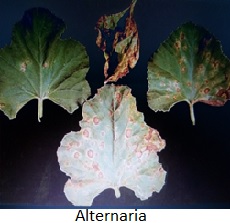
Cercospora
Disease may start where humidity is high, i.e. within dense vegetation. Symptoms are small circular spots having dark green to purple margins, becoming white to light tan in the centre. The leaf lamina around the spots may become chlorotic and eventually the entire leaf may turn yellow and fall off.
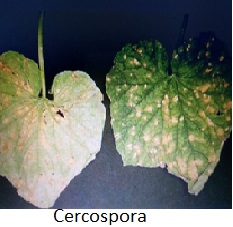
Septoria
Spots are normally circular or occasionally irregular, beige to nearly white in color, measuring 1-2 mm in diameter or occasionally larger on the upper leaf surface. A narrow brown border surrounds the spot and, with age, the lesion may crack.
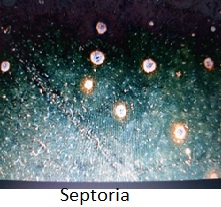
Scab (Cladosporium)
Foliar symptoms include water-soaked spots in early stages that progress into angular or circular necrotic lesions, drying up and falling out. An area of olive-gray fungal mat may be present in the lesions. Affected fruit have large sunken lesions with water soaked margins, that later develop corky “scabs” and may ooze a golden brown sap.
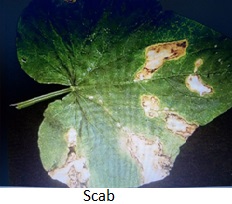
Gummy Stem
Symptoms appear as circular tan to black spots on the leaves that give it a “scorched” appearance. On the stem, symptoms are easily recognized as light tan necrotic areas that appear to ooze a clear to brownish sap, gum or resin from which the disease gets its name. Fruit develop water soaked lesions that eventually turn brown and ooze a sticky sap.
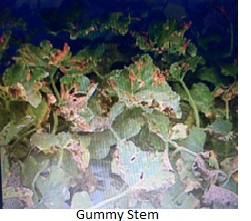
Phytophthora Root Rot
Plants may wilt suddenly, but often stay green.
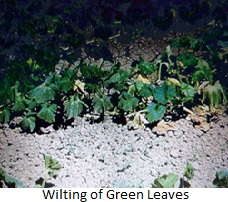
Verticillium
Similar to Phytophthora.
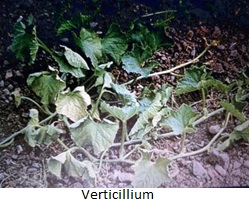
Fusarium Oxysporum
This disease may cause rapid wilting and vine decline of mature plants as they encounter stress. A yellow or brown discoloration may be noticed in the vascular tissue when stem is cut in cross section.
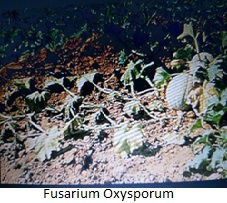
Beet Pseudo-Yellow Virus
Older leaves develop inter-veinal chlorosis that looks like a nutrient deficiency. The yellow areas between the veins becomes thickened and brittle as the disease develops and eventually become necrotic lesions.
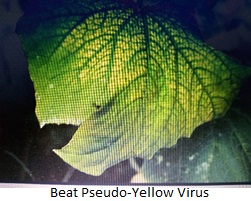
Bacterial wilt (Erwinia)
First symptoms include sections of mature leaves wilting, with eventual wilting of whole sections of vines. A sticky, thread like substance can be seen when infected vines are cut and pulled apart. Cucumber beetle spreads this disease.
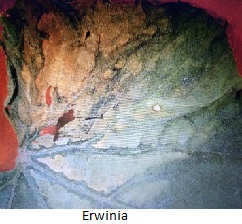
Powdery Mildew
Initially leaves show yellow spots which are soon covered with a whitish powder-like substance. Ultimately leaves dry up.
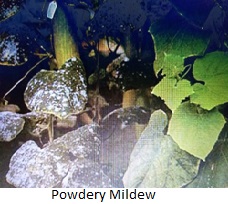
Anthracnose (Colletotrichum)
Anthracnose causes leaf spots which are light brown or reddish, the borders are darker than the centre and appear near veins which may lead to leaf distortion. These lesions dry out and the dead tissue may fall out, as with angular spot. On stems and petioles, lesions are elongated and tan in color. The fruit lesions are large, circular, sunken areas that turn black and may produce a pink ooze.
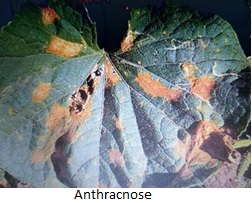
Angular leaf spot (Pseudomonas)
Small, round water-soaked spots appear on the leaf tissue, first on the underside. They expand until they are confined by the veins, giving an angular look. Under moist conditions a milky white liquid ooze out of the lesion on the lower leaf surface. Spots will dry out and turn yellow-brown or the dead tissue may fall out leaving a “shot-hole” appearance. Spots may appear on stems and petioles, drying out to form a whitish crust. Spots can also appear on fruit, where they dry to form whitish, chalky, spots. These spots cause internal decay of fruit.
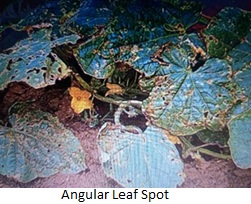
Downy Mildew
The beginning symptoms are yellowish spotting turning brown on the leaves. A white to brown mat of fungal mycelia occurs on the lower side of the leaf.















